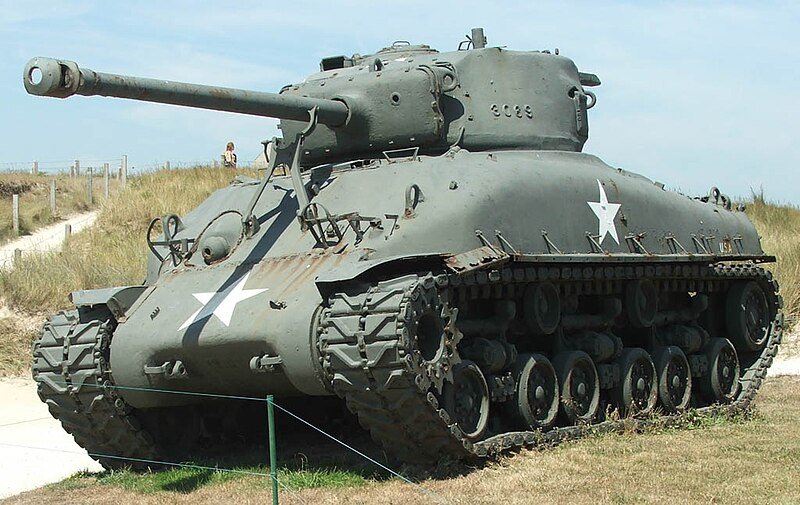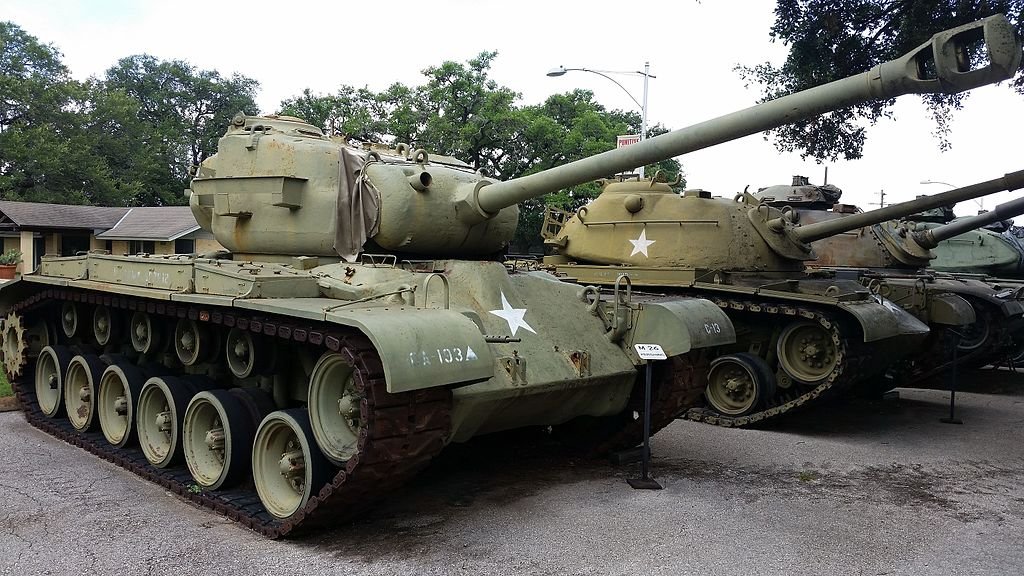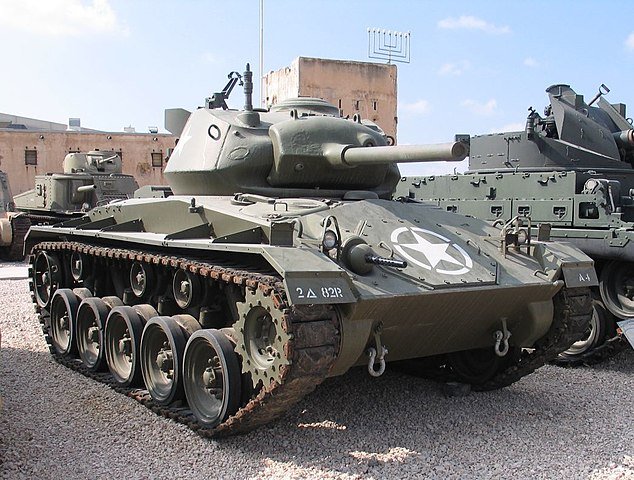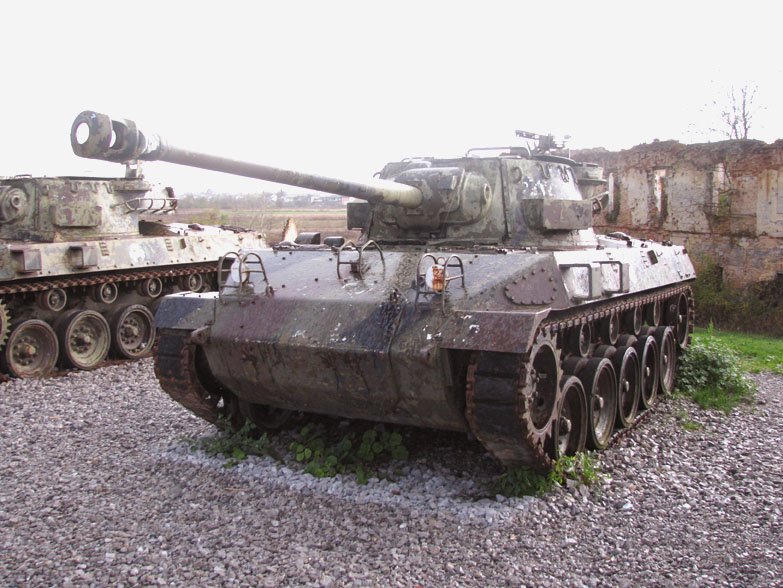During World War II, the Nazis and Soviets embraced the concept of Blitzkrieg, focusing on using tanks for swift breakthroughs in battle through their speed, armor, and firepower. In contrast, the British and French maintained a more conservative approach, viewing tanks primarily for reconnaissance and infantry support. As a result, Allied tank capabilities were relatively lacking until the introduction of American tanks in 1942.
The fighting in the North African desert, spanning from 1940 to 1943, heavily relied on tanks. British forces deployed tanks such as Crusaders, Valentines, and Matildas, which had lighter armaments and were prone to mechanical issues. However, starting in 1942, Britain began benefiting from a significant influx of American tanks, including the Chaffee and Sherman models, which greatly bolstered their armored forces. This infusion of American tanks provided the Allies with improved firepower and durability on the battlefield.
M4 Sherman

During World War II, the M4 Sherman tank emerged as the predominant American tank, serving as a vital asset in various combat theaters. With over 50,000 units produced from 1942 to 1945, Sherman gained popularity due to its resilience and cost-effective production. Not only did the United States rely on Sherman, but it also became a staple for Great Britain, the Free French, China, and even the Soviet Union.
Initially created as a replacement for the M3 “Grant/Lee” medium tank, the first Shermans rolled off the assembly line in 1942. Upon its initial introduction in 1942 during the North African campaign, the Sherman tank proved to be a formidable force, surpassing the capabilities of the German tanks it faced. With its superior armor compared to the Panzer III and IV tanks of that time, as well as a more advanced gun, the Sherman was considered state-of-the-art.
However, as newer German vehicles entered into service, the balance of power would shift, and the M4 Sherman would face increasing challenges on the battlefield. Designed primarily for infantry support, the Sherman played a crucial role in leading offensives and fortifying defensive positions. While often outmatched by German tanks in terms of firepower, Sherman’s advantage lay in its easier maintenance, often allowing repairs to be carried out directly on the battlefield.
M26 Pershing

Developed as a successor to the renowned M4 Sherman, the M26 Pershing emerged as a heavy tank for the U.S. Army during World War II. However, its journey from concept to combat was fraught with challenges. Prolonged design and development processes, coupled with internal conflicts among the U.S. Army’s leadership, delayed its production. Finally, in early 1945, the first M26 Pershing arrived in European theaters as Germany faced a defensive war on multiple fronts, confronting the advancing Soviet forces in the East and the combined Allied contingent in the North, West, and South.
Despite entering the conflict during its final months, the M26 Pershing showcased its effectiveness against the latest German tanks. Following the war, the M26 was retained and underwent upgrades and advancements. During the Korean War, the M26 was deployed and demonstrated its superiority over the tanks employed by Communist forces. However, it faced challenges in dealing with the demanding terrain and encountered various issues with its systems. Despite its initial obstacles and subsequent improvements, the M26 Pershing left a significant mark in armored warfare history.
M3 Stuart Light Tank

The M3 Stuart, also known as the Light Tank M3, served as an American light tank during World War II. Recognizing the obsolescence of the Light Tank M2 based on developments in Europe and Asia, American tank designers undertook improvements to create an upgraded version. This enhanced design, known as the “Light Tank M3,” featured thicker armor, a modified suspension, and a new gun recoil system.
The M5 variant of the tank was introduced in 1942 and primarily supplied to British and other Commonwealth forces through lend-lease arrangements before the United States entered into the war. The M3 Stuart tanks made their combat debut in the North African campaign, with approximately 170 units utilized by British forces in Operation Crusader from November 18 to December 30, 1941. Notably, Stuarts became the first American-crewed tanks to engage in tank versus tank combat during World War II when deployed against Japanese forces in the Philippines in December 1941.
M24 Chaffe

The M24 Chaffee, an American light tank, played a significant role in the later stages of World War II and continued to serve in post-war conflicts such as the Korean War. Its operational history also extended to the French in the War in Algeria and the First Indochina War. In British service, it was named the Chaffee in honor of General Adna R. Chaffee Jr., a key figure in the development of tank warfare in the United States armed forces.
The development of the M24 Chaffee arose from the recognition of the need for a better-armored light tank with a more powerful gun. The Ordnance Department collaborated with Cadillac, the manufacturer of the M5 series, to design a completely new light tank that incorporated the most favorable features of previous designs and drew from the insights gained through the T7/M7 program. Cadillac produced a pilot model known as the T24, which paved the way for further advancements.
A total of 4,731 M24 Chaffees, including various variants, were produced. The tank entered service with the US Army in the winter of 1944, notably during the Battle of the Bulge. The initial deployment of M24s occurred by chance when the 740th Tank Battalion acquired two of them during the intense conflict. As more vehicles became available, they were progressively employed in the battle. The M24 Chaffee gradually replaced older Stuart light tanks until the end of the war, contributing to the Allied forces’ armored capabilities.
M18 Hellcat

The M18 Hellcat, a tank destroyer utilized by the United States Army in World War II and the Korean War, is renowned for its impressive speed and firepower. With a top speed of 55 mph (89 km/h), it achieved swift mobility by prioritizing minimal armor, incorporating the innovative Torqmatic automatic transmission, and equipping it with the same main gun found on certain variants of the larger Sherman tank. General Motors’ Buick Motor Division undertook the production of the M18, which gained the evocative name Hellcat through Buick’s publicity department.
Originally, an order for 1,000 M18 tank destroyers was placed in November 1943. Buick completed this initial order by January 1944, leading the Army to award a subsequent contract for an additional 1,800 units. Ultimately, Buick manufactured 2,507 M18s during World War II. In their initial month of deployment, the M18s saw limited combat engagement and were primarily employed in roles for which they were not originally intended. However, their first significant combat encounter aligned with their intended purpose when the 4th Armored Division, spearheading General Patton’s advance through France’s Lorraine region towards the Saar River, faced the formidable German Mark V Panzer tank in mid-September 1944.
